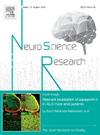Synaptic plasticity induced by CA1 synaptic input with bursts superimposed on low-frequency rhythms
IF 2.3
4区 医学
Q3 NEUROSCIENCES
引用次数: 0
Abstract
Hippocampal neurons fire synchronously in a population at low frequencies and burst individually at high frequencies, with synaptic plasticity thought to depend on the interplay of these firing patterns. This study investigated synaptic plasticity in the hippocampal CA1 region induced by synaptic input with bursts superimposed on low-frequency rhythms. Low-frequency stimulation (LFS) was varied from 0.5 to 5 Hz, and various numbers of bursts (3–1000) consisting of 2–4 pulses at 100 Hz were superimposed on LFS. The patterned stimuli with 1-Hz LFS effectively induced synaptic plasticity. The direction and magnitude of plasticity depended on the number of bursts. We identified key roles for adenosine A1 receptors and GABAergic signaling in regulating synaptic plasticity. The blockade of adenosine A1 receptors increased the magnitude of long-term potentiation induced by specific burst patterns and differentially affected synaptic plasticity induced by 1-Hz LFS. Through its interactions with hippocampal rhythms and inhibitory circuits, adenosine elevated extracellularly during conditioning stimuli regulated the magnitude and direction of synaptic plasticity. This study proposes hypotheses for the role of adenosine in the modulation of synaptic plasticity, which maintains the balance between potentiation and depression in hippocampal circuits.
低频节奏叠加CA1脉冲突触输入诱导的突触可塑性
海马体神经元在群体中以低频率同步放电,在高频率单独爆发,突触的可塑性被认为取决于这些放电模式的相互作用。本研究探讨了低频节奏叠加的突触输入对海马CA1区突触可塑性的影响。低频刺激(LFS)在0.5 ~ 5 Hz范围内变化,在LFS上叠加由2-4次100 Hz脉冲组成的不同次数的脉冲(3-1000次)。1 hz LFS模式刺激能有效诱导突触可塑性。塑性的方向和大小取决于爆发的次数。我们确定了腺苷A1受体和gaba能信号在调节突触可塑性中的关键作用。腺苷A1受体的阻断增加了特定爆发模式诱导的长期增强的强度,并对1 hz LFS诱导的突触可塑性产生了差异影响。通过与海马节律和抑制回路的相互作用,腺苷在条件反射刺激下的细胞外升高调节突触可塑性的大小和方向。本研究提出了腺苷在突触可塑性调节中的作用假设,突触可塑性在海马回路中维持增强和抑制之间的平衡。
本文章由计算机程序翻译,如有差异,请以英文原文为准。
求助全文
约1分钟内获得全文
求助全文
来源期刊

Neuroscience Research
医学-神经科学
CiteScore
5.60
自引率
3.40%
发文量
136
审稿时长
28 days
期刊介绍:
The international journal publishing original full-length research articles, short communications, technical notes, and reviews on all aspects of neuroscience
Neuroscience Research is an international journal for high quality articles in all branches of neuroscience, from the molecular to the behavioral levels. The journal is published in collaboration with the Japan Neuroscience Society and is open to all contributors in the world.
 求助内容:
求助内容: 应助结果提醒方式:
应助结果提醒方式:


